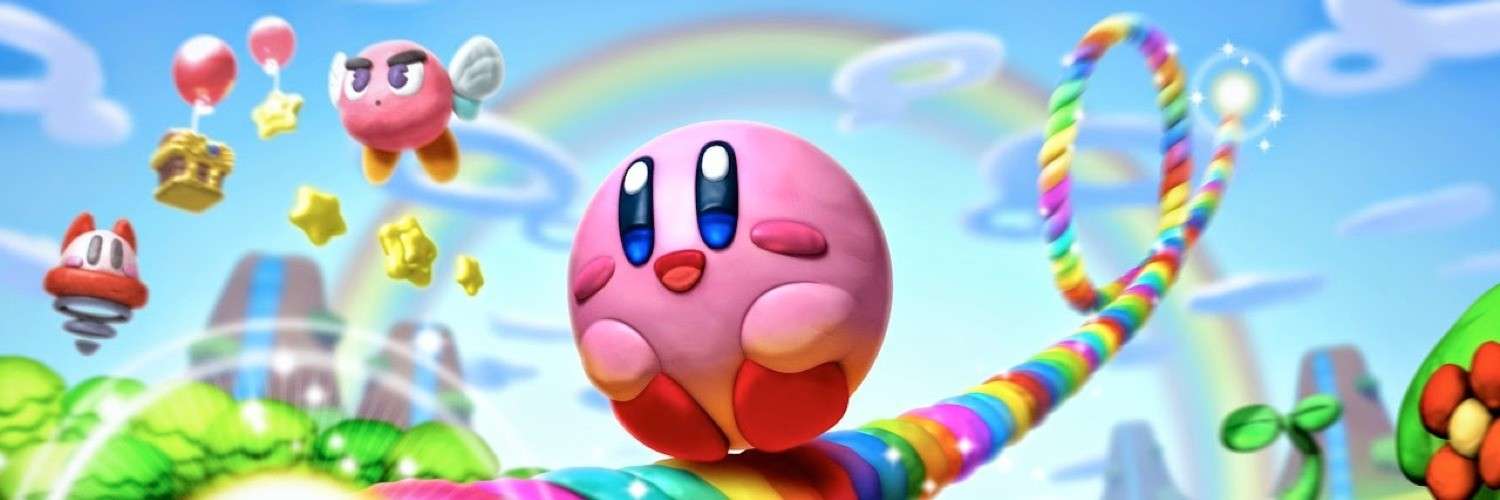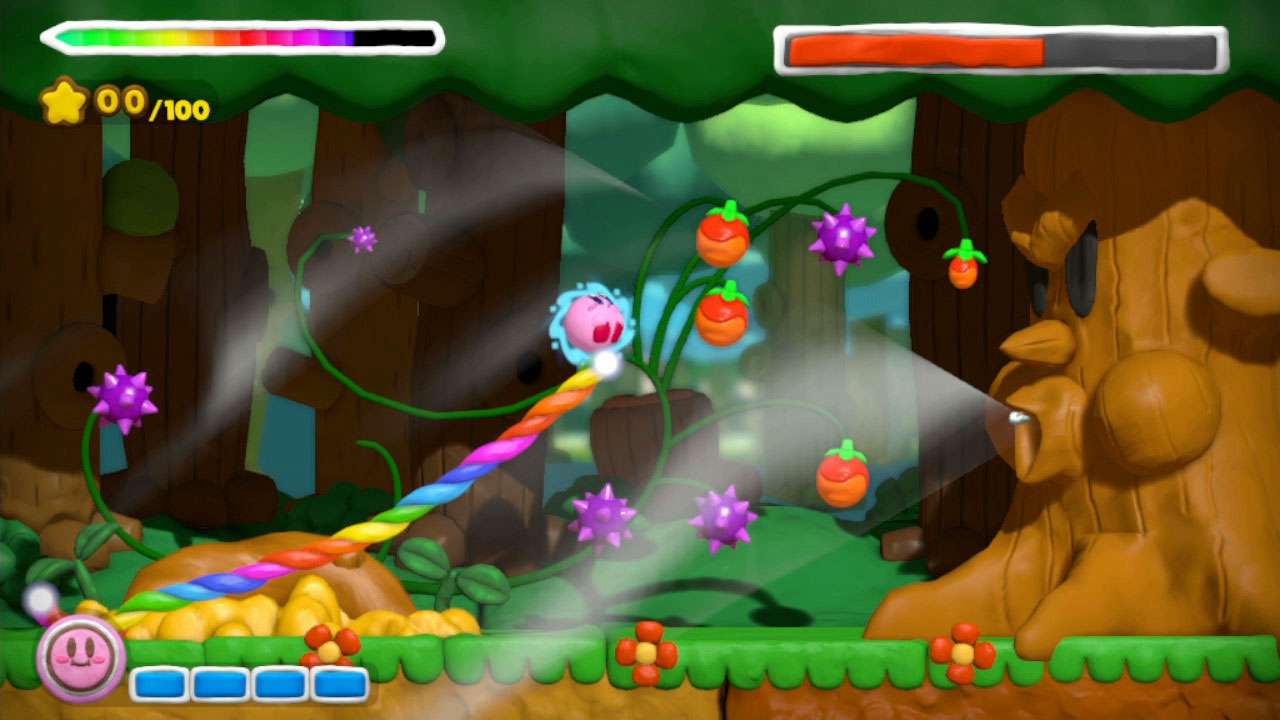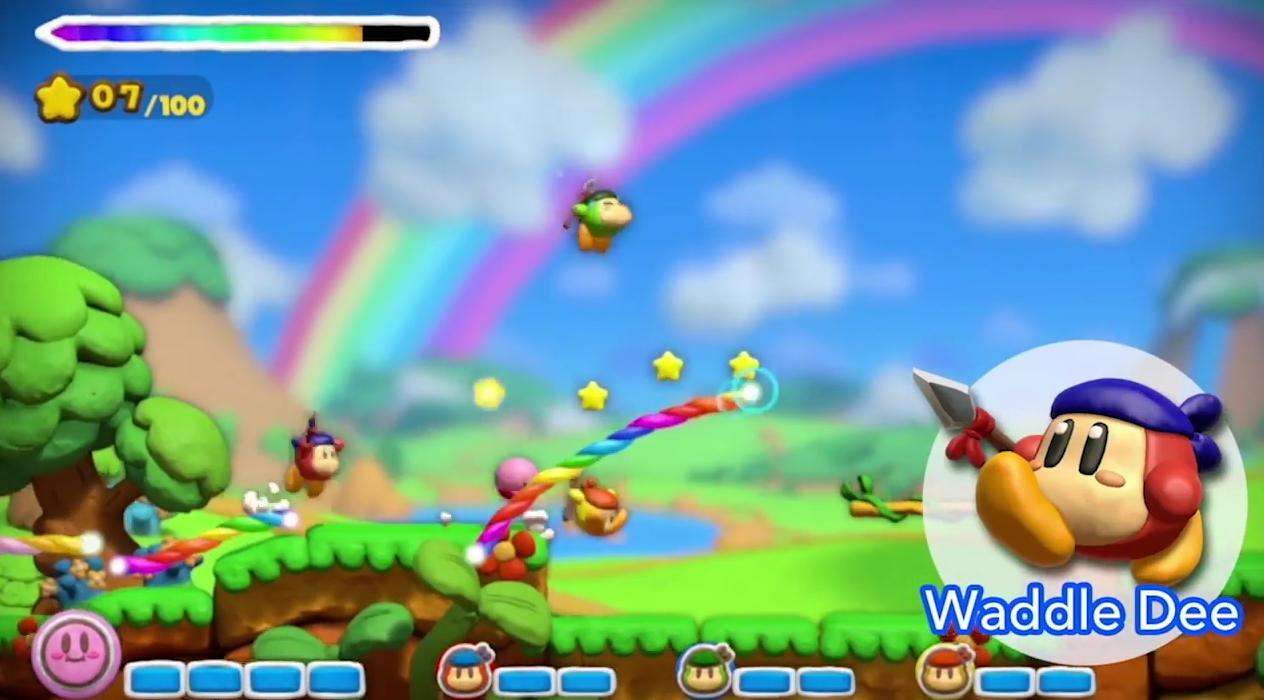
Kirby and the Rainbow Curse Wii U Review
The pink puffball rides again. Kirby’s first official foray onto the Wii U (not including his appearance in Super Smash Bros) is another cute and fun adventure that brings to the table something the console has been lacking: games that utilize the touchpad. However, some of that ends up as problems, however minor, for the game itself.
In this spiritual follow-up to Kirby’s Canvas Curse on the Nintendo DS, Kirby is just chilling out and having a good time, about to eat and be merry, when suddenly all of the color is sucked out of the world, leaving everything gray and frozen. Out of the hole that appeared in the sky, however, a sentient paintbrush girl named Elline comes down and restores color to Kirby and his nearby friend, Waddle Dee. It turns out that Elline’s sister, Claycia, has decided to steal all the color because, you know, evil. The two sisters had created a bunch of creatures that end up becoming your enemies under the hands of Claycia, who literally sends a pair of evil hands after you routinely throughout the game. Now it’s up to Kirby (and up to three Waddle Dees) to save Popstar from the evil that has befallen it.
This game takes its cues from Canvas Curse, where the player must draw rainbow lines to allow Kirby to move around the environment and reach heights not previously attainable. An ink meter in the top left shows you how much you have left before you’re unable to draw any more lines, though the wait time is very short until you’re back in action. One problem in this, the main attraction of the game, is that controlling Kirby via lines and taps isn’t always very fluid. Sometimes Kirby will find it necessary to start moving backwards, forcing you to block him off and right the ship. Other times he won’t listen at all, though this doesn’t happen often enough to create too much annoyance. There is also a special ability upon getting 100 stars: the ability to charge up with a touch and hold on the gamepad, allowing Kirby to become giant-sized and to fly across the screen like a missile. It’s useful to break through steel blocks, which otherwise would remain inaccessible.
Another cue Rainbow Curse takes from a Masahiro Sakurai-directed game is from Super Smash Bros in the goodies you can get. Throughout each stage are five treasure chests you can find and collect (see: giant-sized Kirby), which contain either trophies or music. The descriptions on the trophies are very amusing to read (well worth it to look through each one), and the music is a treat to listen to. All of your collectibles are in one area, and the sound test has a combination of new music from the game and old music from previous entries in the Kirby franchise. While listening to some of Kirby’s old hits is always fun, it’s nice to hear his new cuts, as the game continues bringing great music to the franchise. There are also diary pages, which can be collected at the end of the game via a rotating circle (you can also get extra lives or stars, but the diary pages are the only thing really worth concentrating on). They’re short but cute, with little illustrations from Elline.
One new thing that was absent from Canvas Curse (though was present in Kirby’s Return to Dreamland) is multiplayer. One Kirby and three Waddle Dees can team up through drop-in/drop-out co-op to save the world. In truth though, the Kirby player may get the short end of the stick here. Playing as Waddle Dee is more akin to Kirby’s normal platformers (like Kirby 64). You get to walk around under your own power, float around, and attack enemies and other plot progressers with a spear. You can even walk on Kirby’s rainbow lines, almost turning Kirby into an artistic escort. The only issue to playing as Waddle Dee is the strange inertia he has: occasionally you’ll find yourself forced into the direction you chose, having to wait until he’s nice and situated before turning the other way. This can be problematic, especially when standing atop the lines and finding yourself stuck in mid-air. The lines can also bar you from progress, as Waddle Dee cannot bypass them. This leads to getting stuck behind or under lines, waiting until either they’ve vanished or Kirby’s progressed far enough that you automatically teleport to him. Of course, Kirby isn’t entirely useless. After all, you’re not allowed to enter doors unless you’re Kirby, and only he can break steel bars.
The artwork within the levels is very beautiful. The careful crafting of the clay is apparent in every level, and the environment even reacts appropriately, such as giving way slightly when Kirby bounces off the ground. It all looks gorgeous, and shows off the care that was put into creating the clay environment. With only 28 levels though, the game can feel sort of short, and relatively easy due to the amount of lives you’ll accrue. There’s still challenge however, especially since you can at least die, unlike in Kirby’s Epic Yarn. Besides collecting all of the treasure chests and diary pages, there are also challenge stages that open up upon beating a level. These come down to retrieving treasure chests in a small amount of time (15 seconds), and some can be very difficult to beat. These help give the game some extra playability, and are a lot of fun in their own right.
Despite some issues with controlling Kirby via the lines, the game wouldn’t be the same without it. It’s cute, charming, and lots of fun, with enough challenge to stand up on its own right among other platformers. It also helps to not involve any of the sometimes-cringe worthy dialogue from Epic Yarn. I blame the yarn indeed. For any fan of platformers, this is a game worthy of your shelf space.



